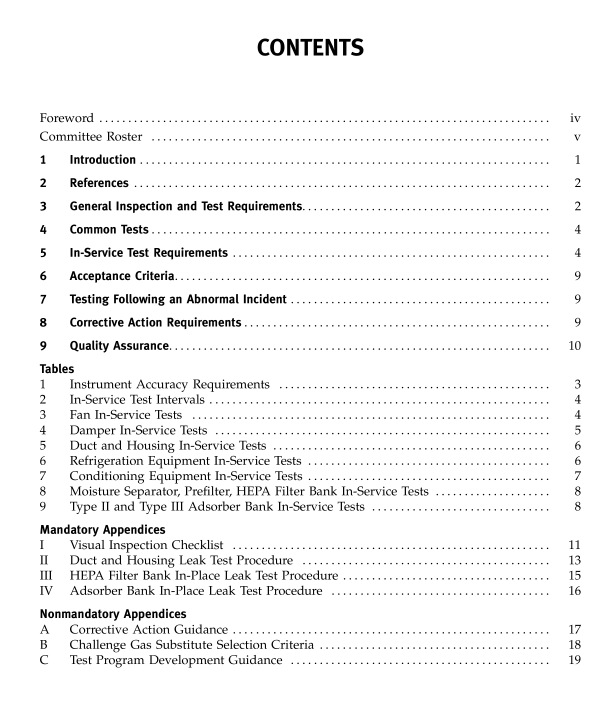ASME N511:2007 pdf download In-Service Testing of Nuclear Air Treatment, Heating, Ventilating, and Air-Conditioning Systems
1INTRODUCTION1.1 Scope
This Standard covers the requirements for in-servicetesting of nuclear safety-related air treatment, heating,ventilating, and air-conditioning systems in nuclearfacilities.
1.2 Purpose
The purpose of this Standard is to provide require-ments for in-service testing. the results of which areused to verify that the nuclear air treatment, heating,ventilating, and air-conditioning systems perform theirintended function.
1.3 Applicability
This Standard applies to the in-service testing ofnuclear air treatment, heating, ventilating, and air-con-ditioning systems that have been designed, built,andacceptance tested in accordance with ASME AG-1.Sections of this Standard may be used for technical guid-ance when testing air treatment, heating, ventilating.and air-conditioning systems designed and built to otherstandards.
1.4 Use of This Standard
This Standard provides a basis for the development oftest programs and does not include acceptance criteria,except where the results of one test influence the per-formance of other tests. Based on the system design andits function(s), the owner shall develop a test programand acceptance criteria.
Nonmandatory Appendices A through C provideadditional information and guidance.
1.5 Definitions
The definitions provided in this section supplementthose listed in ASME AG-1,Article AA-1000.
abnormal incident: any event or condition that mayadversely affect the function of the nuclear air treatment,heating, ventilating, and air-conditioning systems.
acceptance test: a test made upon completion of fabrica-tion, installation, repair, or modification of a unit, com-ponent, or part to verify to the user or owner that theitem meets specified requirements.
adsorbent: a solid having the ability to concentrate othersubstances on its surface.
adsorber: a device or vessel containing adsorbent.
adsorber bank or filter bank: one or more filters or adsorb-ers secured in a single mounting frame, or one or moreside by side panels containing poured or packed airtreatment media,confined within the perimeter of aduct, plenum, or vault cross section, sometimes referredto as a stage.
aerosol: a stable suspension of particles,solid or liquid,in air.
challenge: to expose a filter, adsorber, or other air treat-ment device to an aerosol or gas of known characteris-tics, under specified conditions, for the purpose oftesting.
challenge aerosol: an aerosol used for in-place leak testingof installed HEPA filter systems.
NOTE: The polydispersed aerosol used for in-place leak testingof systems differs in size from the 0.3 um monodisperse DOPaerosol used for efficiency testing of individual HEPA filters bymanufacturers For potential substitutes for DOP, reference ASMEAG-1,Article TA-2000.
challenge gas: a gas of known characteristics used for in-place testing of adsorbers.
HEPA filter (high-efficiency particulate air filter): a dispos-able, extended media, dry type filter enclosed in a rigidcasing that exhibits a minimum efficiency of 99.97%when tested with an essentially monodisperse 0.3 umtest aerosol.
in-service test: a test to determine the operational readi-ness of a system or component.
pressure,maximuim operating: the maximum pressure thesystem components will be subjected to while per-forming their function, including the allowable pressureduring abnormal operating conditions, that will notphysically damage the system or component (e.g., sud-den closure of dampers or registers).
pressure,operating: the pressure that corresponds to thenormal design operating mode of the system.This pres-sure is less than or equal to the maximum operatingpressure.
pressure, structural capability: the pressure, includingtransients, that verifies the component or system can besafely operated without permanent distortion.
reference value: one or more test parameters that are mea-sured, observed, or determined when the equipment orsystem is known to be operating acceptably within itsdesign basis limits.
system: an assembly of components, including associatedinstruments and controls, required to perform the func-tion of a nuclear air treatment, heating, ventilating, andair-conditioning system.
test boundary: the physical limits of the component, sys-tem, or device being subjected to a specified test.
test canister: a specially designed sample holder con-taining adsorbent for laboratory tests that can beremoved from an adsorber bank, without disturbingthe remainder of the adsorber, to provide representativesamples for laboratory testing.
test progran: a documented plan for in-service testingbased upon system design specifications and functionalrequirements,including required tests,test frequency,detailed procedures, and acceptance criteria.
2REFERENCES
The following references supplement this Standardand are a part of it to the extent indicated in the text.The issue date of the referenced document noted belowshall be in effect. If no date is listed, the latest editionand addenda are applicable.
ANS 3.1-1999,Selection,Qualification, and Training ofNuclear Power Plant Personnel
Publisher: American Nuclear Society (ANS), 555 NorthKensington Avenue,LaGrange Park,IL 60526
ASME AG-1,Code on Nuclear Air and Gas TreatmentPublisher: The American Society of MechanicalEngineers (ASME),Three Park Avenue,New York,NY10016-5990; Order Department: 22 Law Drive,PO.Box 2300,Fairfield, NJ 07007-2300
ASME N511:2007 pdf download
